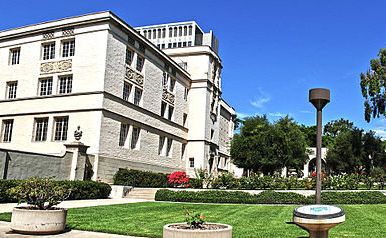
Young Americans look to a college education as the surest way to bridge the widening gap between the richest and the rest in this new 21st century Gilded Age.
But as they try to study their way toward a secure future, millions of current and former students are finding themselves increasingly trapped by soaring debt and diminished job prospects -- and an Obama administration that has largely failed on its promise to better manage and reduce the debt load of a higher education.
Students and Democratic leaders have an assignment for President Barack Obama in his State of the Union address Tuesday night: They want him to recognize borrowers' plight and propose new programs to deal with it. But higher-education advocates and experts in the field also want him to deal with what can only be regarded as the mess the U.S. Department of Education has made of its $1.1 trillion portfolio of student loans.
The department, run by one of the president's closest friends in the cabinet, fellow Chicagoan Arne Duncan, has been accused of ignoring complaints from borrowers and failing to police its student loan contractors, most notably Sallie Mae. One federal lawmaker has said the Education Department risks becoming a "lapdog" for its corporate partners rather than a watchdog protecting students and taxpayers. It has bungled student debt-relief measures meant to help borrowers, and its record earnings off federal student debt prompted Obama to declare last summer, "Our national mission is not to profit off student loans."
Meanwhile, the average student borrower has seen his debt load surge 44 percent since 2007, to $26,300, thanks to government cutbacks to higher education and colleges’ relentless tuition increases. More than seven in 10 graduates from the Class of 2012 took out loans to pay for their educations. In all, 40 million borrowers have outstanding federal student loans.
College graduates, after adjusting for inflation, earn less today than they did 10 years ago, government data show. And student borrowers are putting off buying a home, purchasing a car and saving for retirement, according to government officials. They’re also cutting back on their spending, borrowing and investments.
Financial regulators, top bankers and senior federal policymakers are worried. Over the past year, they’ve been warning that rising student debt levels risk harming economic growth for years to come. Pressure is mounting on the Obama administration to aid borrowers before their individual burdens cause long-lasting damage to the nation’s economic prospects.
Obama, the first chief executive to have gotten his own education in large part through the federal student loan program he's now responsible for, has said it’s his “personal mission” to help families afford a college education and manage their student debt.
But the failure of a once-celebrated White House initiative suggests that the Department of Education may be his biggest obstacle in fulfilling that goal.
The Special Direct Consolidation program, which ran from January to June in 2012, promised to reduce interest rates and the number of monthly payments for as many as 5.9 million borrowers repaying their federal student loans.
The initiative was meant for borrowers who had outstanding loans from two different government programs: the bank-based Federal Family Education Loan program, which ended in 2010, and the Direct Loan program, which directly lends money to student borrowers from Education Department coffers.
Allowing these borrowers to consolidate their multiple loans under the consolidation program would enable them to make just one payment a month instead of several. To get them to enroll, the government offered to reduce their interest rates by 0.25 percent. The Obama administration said that as a result, fewer borrowers would default, millions of Americans would have more money to spend, and taxpayers would save billions of dollars.
Instead, just 10 percent of those eligible for the initiative, or about 585,000 borrowers, were able to take advantage of it, according to an investigation by The Huffington Post. The White House missed its modest public goal of roughly $39 billion worth of loan consolidations by about two-thirds, government data show. And taxpayers achieved far less savings than the $4 billion Duncan promised to federal lawmakers, potentially threatening the funding for a separate ongoing initiative that caps borrowers’ monthly payments at 10 percent of their discretionary income.
The Education Department has never detailed the failings of the special direct initiative. HuffPost pieced together its findings from various government financial reports, securities filings, White House budget documents, congressional correspondence, and interviews with borrowers, student advocates and current and former government officials.
The issues with the program likely won’t come as a surprise to experts who follow the Education Department’s moves. The agency has stumbled in its attempts to help borrowers manage their student loan bills -- data show about as many borrowers with federal Direct Loans enrolled in income-driven repayment plans during the six-month period ending Dec. 31 as entered default -- and it’s been accused of being too cozy with the companies it pays to deal with borrowers.
The Education Department pays its four main student loan servicers -- Sallie Mae, Nelnet Servicing, the Pennsylvania Higher Education Assistance Agency and Great Lakes Educational Loan Services -- hundreds of millions of dollars annually. About one quarter of the nation's $1.1 trillion in outstanding federal student loans is owned by these and other financial companies. Some of them -- such as Sallie Mae -- were bailed out by taxpayers during the financial crisis.
“The department reaches out to federal student loan borrowers for different reasons in a variety of ways. Ultimately, borrowers communicate most often with their loan servicers and financial aid officers, who most directly assist borrowers with their student loans,” Dorie Nolt, an Education Department spokeswoman, said in a statement. “In 2012, the department reached out to a targeted group of borrowers via e-mail to notify them of the special direct consolidation program, which in turn, helped hundreds of thousands of borrowers better manage their obligations.”
The Education Department, run by Duncan since Obama took office in January 2009, is responsible for annually distributing more than $100 billion in loans to students, as well as supervising the colleges that ultimately receive those funds and the financial companies that collect payments on the loans. There is no federal agency with greater authority to rein in the nation’s growing stack of unpaid student loan bills.
“The department continuously works with its servicers to find innovative strategies aimed at informing borrowers of their repayment options to help them better manage monthly loan payments and remain up-to-date on their payments,” Nolt said.
But the Special Direct Consolidation program's shortcomings show a lack of attention paid to helping borrowers. Separate years-long efforts to aid borrowers with modest incomes have fallen flat, despite high-level attention by the White House.
The department is too reliant on its corporate contractors, a group of student advocates, teachers’ unions and colleges recently charged, and it doesn’t exercise its oversight authority to rein in abuses.
“It seems like the Education Department keeps making the same mistakes over and over again,” said Deanne Loonin, director of the National Consumer Law Center's Student Loan Borrower Assistance Project.
Student advocates and some high-ranking government officials reckon that the Education Department may be struggling to even understand borrowers’ student debt loads and the potential negative consequences of increasing debt burdens. The lack of public data on the department’s $1.1 trillion portfolio hinders attempts to understand potential problems, current government officials, former Education Department employees and industry executives have said.
As a result, other federal agencies have stepped up their efforts. The Consumer Financial Protection Bureau, the regulator responsible for protecting borrowers from abusive lenders, recently announced that it would begin inspecting companies that collect payments on federal student loans.
The Federal Reserve's Board of Governors in Washington and the Federal Reserve Bank of New York are studying the macroeconomic fallout from increasing student debt burdens. The Treasury Department has been talking to industry executives and economists about the potential havoc student loans could wreak on economic growth, banks’ bottom lines and the federal debt.
In December, the American Association of State Colleges and Universities, the American Federation of Teachers, the National Education Association, the United States Student Association, and the workers' rights organization Jobs With Justice, among others, wrote Duncan a letter to complain about his agency’s apparent lack of care for borrowers.
Days earlier, the department had told Sen. Elizabeth Warren (D-Mass.) that it had declined to levy any fines on student loan giant Sallie Mae, despite confidential determinations over the past 10 years that allege the company had harmed borrowers and incorrectly billed the department, among other servicing failures.
“It is simply unacceptable that the Department of Education continues to allow loan servicers to routinely break the rules of these servicing and debt collection contracts and go completely unpunished by your office,” the coalition of teachers, students and colleges wrote.
A group of prominent Senate Democrats recently proposed legislation that would increase protections for student loan borrowers after complaints of mistreatment by the Education Department’s handpicked loan servicers.
In their bill, the lawmakers granted much of the authority to develop new rules governing federal student loans to the Consumer Financial Protection Bureau, rather than the Education Department. The move was viewed as a not-so-subtle rebuke to Duncan’s agency. Obama should take note.
This article is part of a weeklong series examining income inequality in America in advance of President Obama's State of the Union address. Read more here.

